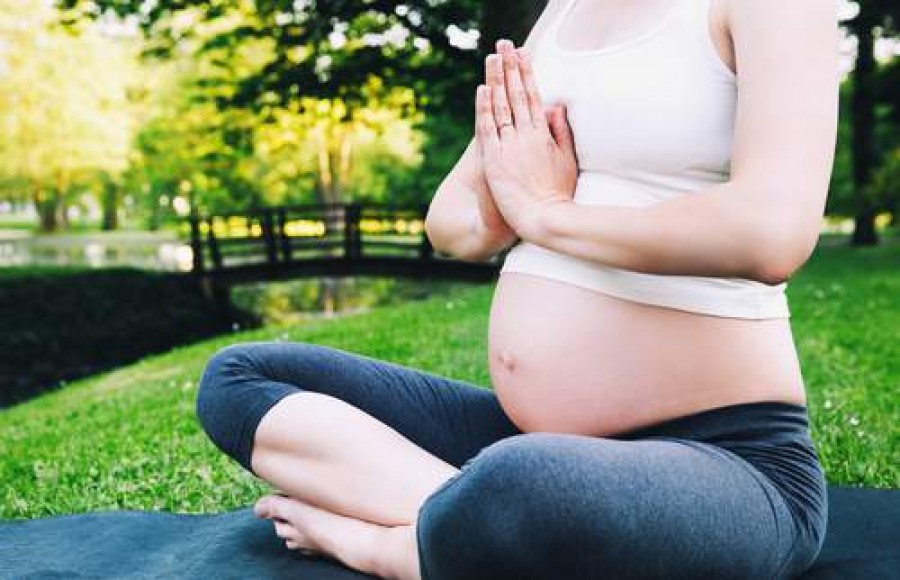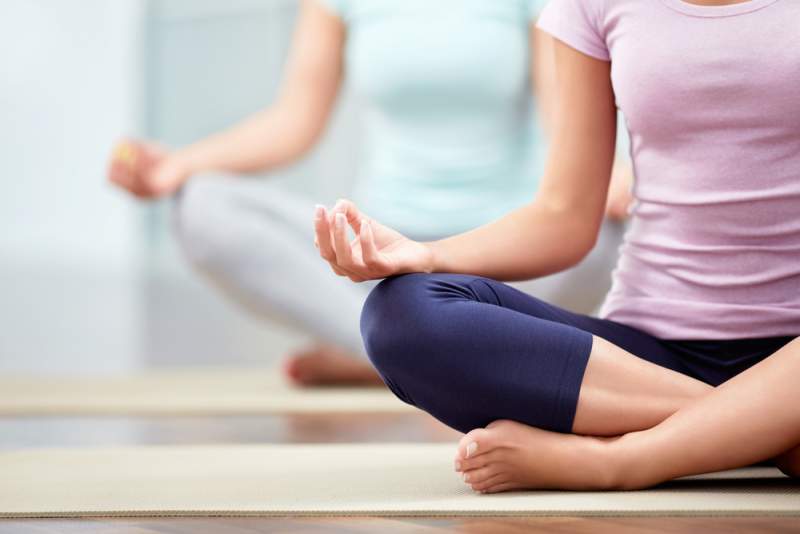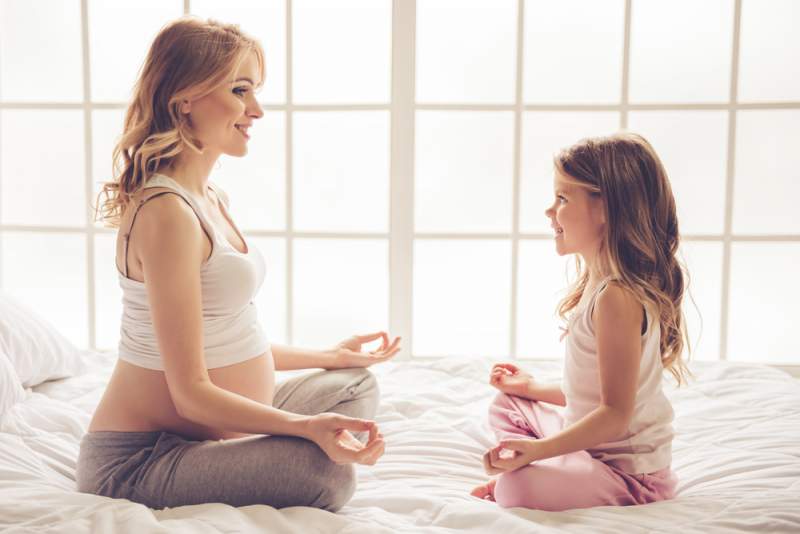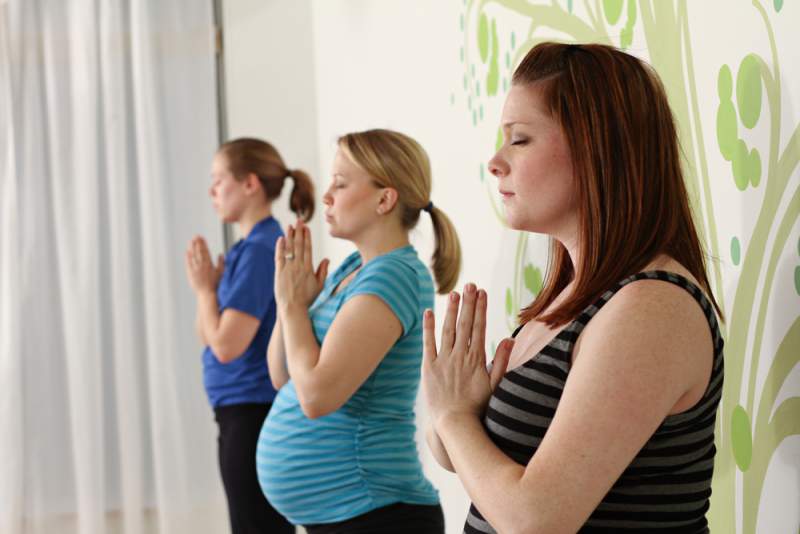Maintaining a Safe Yoga Practice during Pregnancy

Whether you are a seasoned yogini or just considering starting, there are ample benefits to maintaining a yoga practice during your pregnancy. Yoga is not only a great way to keep fit. It has the added benefits of creating a deeper awareness of your body and your mind, connecting you to your bub, and helps you prepare for labour and birth.

First trimester
If you have maintained a yoga practice for a while, it’s probably safe to continue.You may have to slow down or modify some postures as your term progresses; your fitness and practice level will dictate what changes you need to make. Consult your teacher, as well as your doctor, once you have found out about your pregnancy. Although changes may be hard to see on the outside, internally, your body is vigorously creating organs, connecting tissues, and assembling the necessary networks to sustain and nurture the life growing within you. Be kind to yourself and allow your practice to be secondary to rest and nourishment. If you are new and thinking of starting yoga, it may be advisable to wait until you are past 14 weeks.
Beginning with specific antenatal yoga classes can safely ease you into a regular practice.Always consult your health care professional before commencing any exercise program during pregnancy. One thing to remember is, pregnancy will shift your centre of gravity. The new weight you will be putting on and carrying will displace your posture, and your body’s way of compensating could lead to lower back pains. It’s great to focus on standing postures in the first trimester, to strengthen the back, legs and abdomen, and promote circulation.
If you find yourself particularly nauseous at this time as well, continuing your yoga practice can help alleviate your nausea (as well as swollen ankles and constipation!) Keep in mind that, sadly, the first trimester has a higher risk of miscarriage than other stages in your pregnancy. It’s important to listen to your body and take rest if that’s what you require. You can still participate in some breathing exercises that accompany most yoga practices- these will have a great benefit on your overall wellbeing and may help calm the restless mind as your body undergoes changes.
Postures to avoid or modify during the first trimester
Hot yoga (Moksha or Bikram) are discouraged throughout pregnancy, but particularly for the first trimester. The concern is that progesterone lowers blood pressure, and heat can cause fainting. Studiesare inconclusive about possible birth defects due to heat. Consult your doctor whether it’s safe for you. Deep twists: focus on upper back and shoulders, rather than deep abdomen. Implantation of the embryo and the attachment of the placenta occur in the first trimester, abdominal twists may disturb the uterus and cause complications.
Abdominal/core strengthening: planks may be okay, but keep in mind that your uterus is trying to expand and over-strengthening is counterintuitive. Prone (belly-down) strengthening postures may become uncomfortable as your term progresses. Also, you don’t want to overstretch the abdomen— avoid deep bends. Back-bending can feel great, but stay gentle and proceed slowly. Avoid deep bends. Inversions are not recommended because they divert blood away from the uterus. If you absolutely cannot live without them, don’t hold longer than 20 seconds. Avoid laying on your back (shavasana) past 16 weeks. Modify to a left side-lying shavasana for 20 minutes after class. Left side to prevent unwanted pressure on the vena cava (which is on the right) and moves the blood from the lower body— namely your uterus— back to the heart. Being able to relax on cue after physical activity will help you during labour.

Second trimester
Hopefully the rapid changes (and morning sickness) have subsided and you feel somewhat like yourself again! As you’re starting to get that pregnancy glow, you may find new strength and endurance capacity. While physical activity is encouraged, remember to check in with your health care practitioner to ensure your pregnancy is complication-free and that you can continue your practice. Remember not to push yourself too much: slowing down or taking a break during a particularly active vinyasa flow can be more valuable than over-doing it.
It’s equally important to not over-do the stretching during your pregnancy. Although it may feel really good to open up and feel increased flexibility, use caution. Your body is producing a hormone called relaxin to soften joints and ligaments,and loosen your muscles to prepare for labour. It’s easy to sprain or dislocate tissue, so try to not be tempted to extend beyond your regular range of motion. A lot of advice from the first trimester can be translated into the second. Here are some additional guidelines to consider:
Postures to avoid or modify during the second trimester
Prone positions (belly down) are probably becoming really uncomfortable, the more you begin to show. Substitute with table top, and arch your back up and down as you would with cat/cow, alternating with extended arm/leg to achieve the same benefits. You may want to reduce the time you hold Asanas so you don’t over-exert yourself or damage joints as you try to balance your rapidly changing shape.
Avoid forward bends or postures that compress the stomach. Modify them by widening your feet to hip width in standing postures, or sitting wide-kneed to create room for your protruding bump. These will stretch your inner groin and thighs to accommodate labour. Downward dog is still good for alleviating lower back pains! Opt for non-weight bearing back bends such as the camel pose, as deeper bends that focus on the lower back can put too much strain on the abdomen, and pressure uterus, can lead to diastasis recti (abdominal separation, yikes!) Balancing postures can become unpredictable as your weight and centre of gravity continue to shift. Practice near a wall so you can brace yourself if the need arises.

Third trimester
The final stretch is here! The last trimester is a good time to put emphasis on more meditative or breathing-focused (pranayama) practices, which can help you find your grounding during labour and delivery. Your focus should shift to more antenatal postures as well, to open up the hips and cervix. Plus, a lot of positions may be uncomfortable due to your baby’s size. If you are an apt yogini and yoga has always been a lifestyle for you, feel free to continue challenging poses.And, if you’re not, that’s great too, just do what feels right for you.
Your teacher should be fully supportive. Be mindful of your breath (even more than before!) It’s a great guide for making modifications to postures or slowing the pace. You can use breath to really bond with your bub and figure out what works for both of you, in this last stage. As with the first and second trimesters, carry on with avoiding or modifying postures as advised. Some others to think of at this time are:
Positions to avoid or modify during the third trimester
Avoid all inversions after 36 weeks. Your baby has or is in the process of “flipping” his head down to the uterus and inversion could disturb that. Inversions may also worsen conditions like heartburn. As with inversions, balancing can be really detrimental at this stage due to safety and the risk of falling over. Enlist in the help of your partner for balancing postures.
Whether you are doing yoga at home on your own or at a class, use your practice to gain mental clarity and a deeper awareness of your changing body. Yoga can be an incredible tool to really connect with your baby, through breath and movement, as well as prepare your body for labour and birth. Cherish the feelings and sensations, and enjoy experimenting with what works for you and your bub! Namaste!



